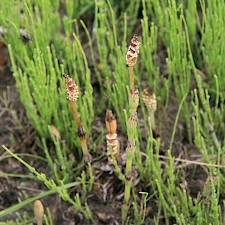Field horsetail
Botanical Name
Equisetum arvense
Family
Equisetaceae (horsetail)
Also known as
Common horsetail, scouring rush
Where is it originally from?
Temperate northern hemisphere
What does it look like?
Erect, colony-forming, summer-green perennial, primitive fern-ally (<10-80 cm) with extensive, deep, freely branching rhizomes with round tubers. All aerial parts die back in winter. Stems are of two types: (1) sterile stems (10-80 x 1-5 mm diameter) are green, jointed, hollow, ribbed or grooved, very rough to touch (containing silica), with lateral branches in whorls and leaves (10mm) which are green sheaths. Resembles a pine seedling, and (2) fertile stems are pale brown, shorter with larger joints, unbranched, with pale brown 14 mm sheaths, appear in early spring before sterile stems, produce conspicuous (4-40 mm long) terminal cones, and die quickly after shedding spores. Spores are seldom produced in New Zealand.
Are there any similar species?
Rough horsetail (Equisetum hyemale) is very similar but rare, it has slender, taller, very rough, asparagus-like spears with black rings, no leaves, no (or very occasionally few small) branches, cones on green stems. E. fluviatile (rare).
Why is it weedy?
Matures and spreads quickly, forming dense, long-lived mats. Tolerates flooding to dampish-dry soil, warm to very cold, wind, and deep burial but is intolerant of dry soils. Toxic to stock.
How does it spread?
Rhizomes and tubers are spread by water, soil and river gravel movement and contaminated machinery. Sources include rivers, roadsides, pasture, and gardens, where it has been found being grown as a homeopathic remedy.
What damage does it do?
Forms pure stands in wide range of damp habitats, preventing the seedlings of native species from establishing. Blocks and alters watercourses, causing flooding.
Which habitats is it likely to invade?
Bare land, river systems especially silty, sandy and gravelly sites, and streambanks.
What can I do to get rid of it?
1. Dig out and incinerate all parts and contaminated soil.
2. Spray (summer): metsulfuron-methyl 600g/kg (5g/10L) or a product containing 100g picloram+300g triclopyr/L (25ml/10L). Add penetrant.
CAUTION: When using any herbicide or pesticide, PLEASE READ THE LABEL THOROUGHLY to ensure that all instructions and directions for the purchase, use and storage of the product, are followed and adhered to.
What can I do to stop it coming back?
Resprouts constantly from rhizomes and tubers. Resistant to most herbicides, extremely difficult to kill. Lowering watertable can slow rate of spread.









